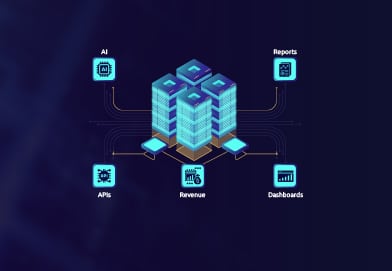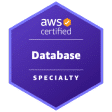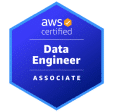For many enterprises, the promise of data has always been clear, but the reality is often messier. Fragmented systems, inconsistent data quality, and painfully manual processes often prevent timely, trustworthy insights. As data volumes continue to explode, traditional data warehousing methods are struggling to keep up.
Enter artificial intelligence.
AI is no longer a futuristic idea; it’s a driving force for smarter, faster, and more automated decision-making. A Forbes Advisor survey found that 64% of businesses believe AI will significantly boost productivity. And with the global AI market expected to reach $1.81 trillion by 2030, its impact is undeniable.
While the potential is massive, realizing AI’s full impact requires overcoming real technical and organizational challenges.
This transformation is most clear in data warehousing. From automating data pipelines and improving data quality to unlocking predictive insights, AI is reshaping how organizations manage and get value from their data.
Many enterprises are eager to adopt AI, but scaling it within legacy systems or fragmented environments requires strategic alignment. This article explores how AI is driving the next evolution of data warehousing and what that means for the future of data-driven businesses.
The Evolution of Data Warehousing
Data warehousing emerged in the late 1980s as a centralized repository to store integrated data from multiple sources for reporting and analysis.
Over the years, data warehouses have evolved into more sophisticated systems, enhancing data aggregation, storage, and retrieval efficiencies. With the advent of big data and cloud computing, data warehousing became more scalable, flexible, and cost-effective.
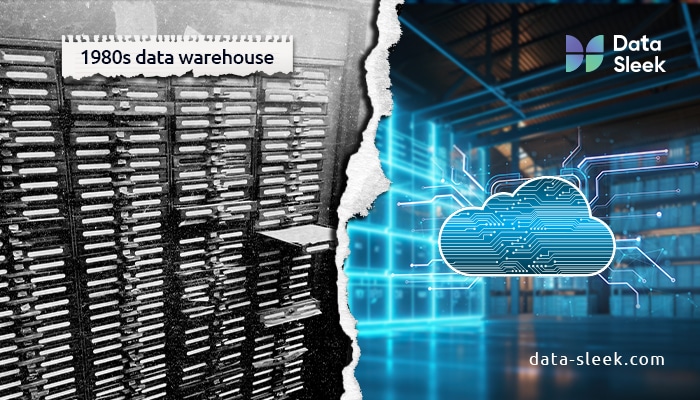
Today, a data warehouse is an intelligent system capable of predictive analytics, real-time data analysis, and data visualizations and providing actionable insights, marking a new chapter in the ongoing evolution of data warehousing.
The Emergence of AI in Data Management
The integration of AI into modern data warehouses marks a major shift in how organizations manage, analyze, and act on data. What was once a passive storage layer is now becoming an intelligent platform that can automate workflows, improve data quality, and power advanced analytics in real time. For many organizations, realizing these benefits requires aligning data strategy, infrastructure, and talent, not just adding new tools.
Two AI-driven innovations stand out for their transformative impact: Machine Learning (ML) and Natural Language Processing (NLP).
Machine Learning in Modern Data Warehouses
ML algorithms are integrated into modern data warehouse platforms to make predictive models that enhance data analysis and decision-making processes. These algorithms can identify patterns and anomalies in large data sets that would be impossible for humans to detect manually.
For instance, ML can be used for predictive analytics, forecasting future trends based on historical data stored in the warehouse. This capability enables businesses to make proactive decisions, anticipate market changes, and personalize customer experiences.
Furthermore, in real-time data warehouses, artificial intelligence is instrumental in automating data governance tasks such as data quality checks, classification, and anomaly detection, helping ensure that the raw data in the warehouse is accurate, consistent, and reliable.
Natural Language Processing in Data Warehousing
NLP enhances accessibility by allowing users to query data using plain language. This democratizes analytics across departments, enabling business users to generate insights without needing SQL expertise.
NLP is also instrumental in extracting insights from unstructured data sources such as emails, survey responses, or customer feedback, adding a new dimension of analysis to the data warehouse.
AI in OLAP vs. OLTP: Different Roles, Different Outcomes
A subtle but important distinction lies in how AI is applied across OLAP (Online Analytical Processing) and OLTP (Online Transaction Processing) systems, especially for organizations making architectural decisions.
In OLAP environments like data warehouses, AI is focused on strategic intelligence: predicting trends, surfacing anomalies, and enhancing business decision-making through analytics. These systems operate on large volumes of historical or curated data and support use cases like sales forecasting, regulatory compliance analysis, or executive dashboards.
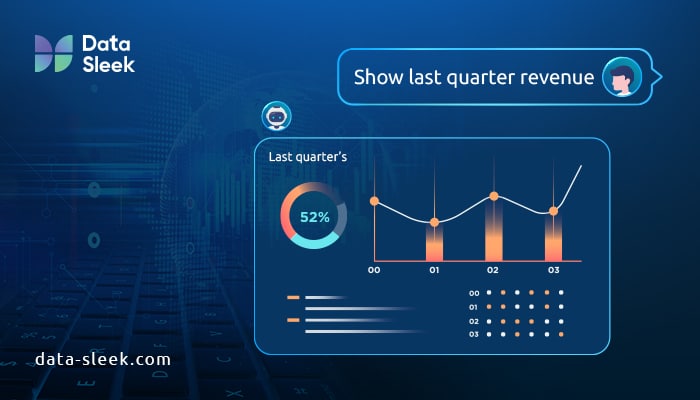
In contrast, OLTP systems (such as CRM platforms, payment gateways, or logistics apps) leverage AI for real-time operational responses. Here, AI supports functions like instant fraud detection, chatbot assistance, or transaction risk scoring, where low latency and transactional accuracy are critical.
For organizational leaders, this distinction matters. While AI-enhanced data warehouses improve cross-functional alignment and long-term planning, AI in OLTP systems fuels customer-facing agility. Understanding where and how to apply AI capabilities across the stack can shape architecture choices, resource allocation, and governance strategy.
AI-Driven Data Warehouse: Key Advancements
Automated Data Integration: How AI Simplifies Data Aggregation from Varied Sources
AI simplifies the traditionally complex process of aggregating data from multiple sources like databases, cloud platforms, SaaS apps, and IoT devices. By automating ELT pipelines, AI accelerates data ingestion, reduces manual intervention, and assists in standardizing formatting by detecting inconsistencies and recommending transformations.
These capabilities improve efficiency and help lay the foundation for intelligent, real-time analytics across the enterprise. This automation not only saves time but also enables near real-time data availability for analytics, supporting more agile decision-making across the business.
Enhanced Data Quality and Governance: Using AI for Cleaning, Deduplication, and Compliance
Maintaining clean, trustworthy data has always been a challenge in large-scale systems. AI improves data quality through automated error detection, deduplication, and intelligent classification. It flags inconsistencies in real time and applies rules-based or learned corrections without manual data wrangling.
AI also supports compliance by tagging sensitive data, enforcing access controls, and helping organizations meet evolving privacy regulations like GDPR or HIPAA more efficiently.
AI for Data Observability and Metadata Intelligence
In addition to integration and quality, AI is also essential to the operational reliability of data platforms. Tools like Monte Carlo and Metaplane use AI to monitor data pipelines, detect upstream failures, and identify anomalies before they reach dashboards. This helps data teams prevent broken reports and degraded analytics.
In addition, platforms such as Collibra, Atlan, and Alation leverage AI to automate metadata management tasks. This includes data lineage mapping, cataloging, and sensitive data classification, which are crucial for ensuring transparency, governance, and regulatory compliance across distributed data environments.
By embedding AI in observability and metadata workflows, organizations reduce manual oversight, maintain trust in their analytics, and scale governance across increasingly complex data ecosystems.
AI’s Role in Forecasting and Trend Analysis within Data Warehouses
AI enhances traditional analytics by uncovering trends and patterns that humans or rule-based systems might miss. Machine learning models can analyze historical data to project future outcomes, enabling use cases like demand forecasting, customer behavior prediction, and fraud detection.
With this capability embedded directly in the data warehouse, business teams can shift from reactive reporting to proactive, insight-driven strategy. Of course, the quality of these insights depends on building accurate models with relevant, high-quality features. Therefore, AI delivers value only when grounded in sound data science practices.
Implementation Across Ecosystems
Leading data platforms are embedding these AI capabilities directly into their ecosystems. For example, Snowflake offers Snowpark ML for in-warehouse model development, while BigQuery ML enables SQL-based machine learning within Google Cloud.
Azure Synapse, when paired with Cognitive Services, supports NLP and vision models at scale. Databricks, known for unified analytics, integrates with MLflow for lifecycle management. Even orchestration tools like DBT now offer AI-assisted transformations via integrations with OpenAI.
These ecosystems allow businesses to implement AI in their data workflows without building infrastructure from scratch.
Case Studies: AI in Action within Data Warehousing
Retail Industry – Predictive Inventory Management
A major retail chain implemented AI in its data warehousing system to optimize data processing and inventory management. By analyzing historical sales data, weather patterns, and consumer behavior trends, the AI system could predict demand for different products at various times of the year.
This led to more efficient stock replenishment, reduced overstocking, and improved customer satisfaction due to better product availability.
Healthcare – Patient Data Analysis and Research
A healthcare provider utilized AI to enhance their data warehousing for patient data. The AI system can process data and help clean, deduplicate, and organize vast amounts of patient data, making it easier for healthcare professionals to analyze data.
This system played a crucial role in identifying patterns in patient symptoms and treatment outcomes, aiding in research for personalized medicine and improving patient care.
Finance – Fraud Detection and Risk Management
A financial institution and its data engineers integrated AI into its data warehousing to improve fraud detection and risk management.
The AI algorithms analyzed transaction data to identify unusual patterns indicative of fraudulent activities. This proactive approach helped minimize financial losses due to fraud and enhanced the bank’s ability to manage risks associated with lending and investments.
E-Commerce – Customer Behavior Analysis for Personalization
An e-commerce company leveraged AI in its data warehousing to analyze customer behavior, preferences, and purchase history. This information created personalized product recommendations for each customer, increasing customer engagement, higher sales, and improved customer loyalty.
Benefits of AI-Enhanced Data Warehousing
Improved Efficiency: Automated Processes Reducing Time and Cost
AI has revolutionized data warehousing by automating several processes. This automation includes data collection, cleaning, continuous data quality monitoring, and other traditional data warehousing tasks.
By reducing the need for manual intervention, AI can significantly speed up processes, minimize human error, and save businesses time and resources.
Better Decision Making: Enhanced Analytics Leading to More Informed Business Decisions
AI-enhanced data warehousing gives businesses more sophisticated analytical tools, leading to better decision-making. By using AI-powered data modeling, companies can extract deeper insights from their data by employing advanced machine learning models and predictive analytics.
AI-driven analytics enables decision-making that’s not only grounded in historical data but also predictive and proactive. This helps organizations act with greater confidence, especially when considering future trends and scenarios.
Scalability and Flexibility: AI’s Role in Adapting to Changing Data Needs
AI-powered data warehousing systems offer scalability and flexibility. They can handle increasing data volumes and adapt to changes in data structures, formats, and sources. This adaptability is crucial in today’s fast-paced business environment, where agility and the ability to respond to market changes quickly can provide a competitive edge.
Challenges in Integrating AI with Data Warehousing
While AI brings significant potential to data warehousing, implementation comes with a complex set of financial, technical, regulatory, and cultural challenges. For organizations pursuing AI at scale, understanding and addressing these roadblocks is critical to long-term success.
High Implementation and Infrastructure Costs
Integrating AI into data warehousing can be a substantial financial investment. The costs are related to acquiring the necessary technology and tools and include the expenses associated with upgrading existing infrastructure to support AI capabilities.
For many organizations, especially small to medium-sized businesses, strategic investments in infrastructure can unlock automation at scale and long-term ROI, even though the upfront costs may be substantial.
Complexity of Implementation
AI introduces new components like machine learning pipelines, orchestration frameworks, and model management systems that must seamlessly interact with existing data warehouses. Ensuring performance, reliability, and interoperability across this growing stack adds architectural complexity.
Many organizations struggle to operationalize AI at scale without strong data engineering expertise. But with the right skills and architecture, success is well within reach. That’s why many turn to data architecture consulting to ensure their systems are designed for scalability, interoperability, and long-term success.
Data Privacy and Security Concerns
The use of AI in data warehousing raises concerns about data privacy and security. AI systems often require access to vast amounts of sensitive data, and ensuring the security of this data against breaches is paramount.
Regulatory compliance, especially with evolving frameworks like GDPR, remains a top priority. Organizations that treat security and governance as foundational, rather than afterthoughts, are better positioned to scale AI responsibly and with confidence.
Bridging the Skills Gap in AI-Driven Data Warehousing
The success of AI-enhanced data warehousing doesn’t hinge on technology alone; it depends heavily on people. As organizations adopt advanced analytics and intelligent automation, many face a critical skills gap.
There’s growing demand for professionals with expertise in machine learning, data engineering, and AI governance, but supply hasn’t kept pace.
Hiring and Talent Shortages
Finding talent with the right blend of technical depth and data strategy experience is a major challenge. Roles like AI engineers, MLOps specialists, and cloud-native data architects are highly competitive, and smaller organizations often struggle to attract or retain them.
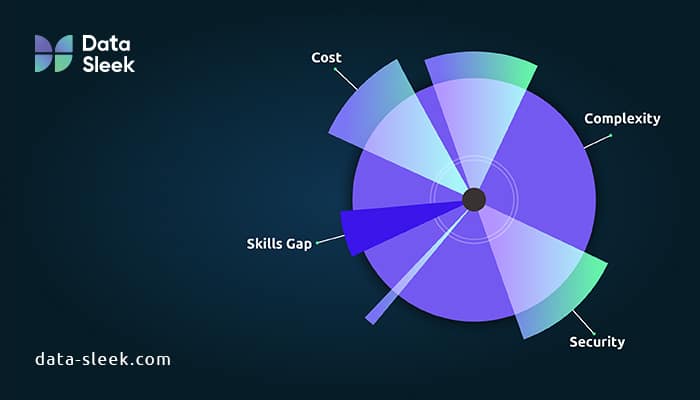
Still, these talent shortages also create an opportunity: forward-looking companies are responding by building internal capability and developing AI-ready teams who can lead future transformation efforts.
Upskilling the Existing Workforce
To bridge the talent gap, many companies are investing in internal training. Upskilling existing data and IT teams in areas like model deployment, data governance, and AI ethics helps reduce dependency on external hires. Strategic training programs aligned with real business use cases, not just theory, are key to accelerating adoption.
Fostering a Culture of Experimentation and Learning
Beyond formal training, AI adoption requires a mindset shift. Teams need the freedom to test, fail fast, and continuously improve. Encouraging collaboration between data scientists, engineers, and business units builds trust in AI systems and promotes shared ownership of outcomes. Organizations that foster a culture of continuous learning are better positioned to evolve with the technology.
The Future of Data Warehousing with AI – Predictions and Trends in AI-Driven Data Warehousing
AI is rapidly reshaping the capabilities of data warehouses, from how data is integrated and processed to how insights are generated and operationalized. As adoption accelerates, here’s what the future holds across near-, mid-, and long-term horizons.
Real-Time AI and Full Automation
In the near term, organizations will see increasing automation of traditional data warehousing tasks like data quality checks, transformation logic, and pipeline orchestration. Real-time processing will become standard, powered by AI systems that can adapt to changing data flows and user queries without manual tuning.
This shift will reduce time-to-insight, enable continuous analytics, and lower operational overhead, turning warehouses from passive data stores into active decision engines.
Deeper AI Integration and Smarter Analytics
Over the next few years, data warehouses will begin to incorporate more advanced AI technologies, including deep learning, cognitive search, and automated anomaly detection. These capabilities will allow organizations to derive meaning from unstructured data, track behavioral patterns, and surface insights that are currently hidden.
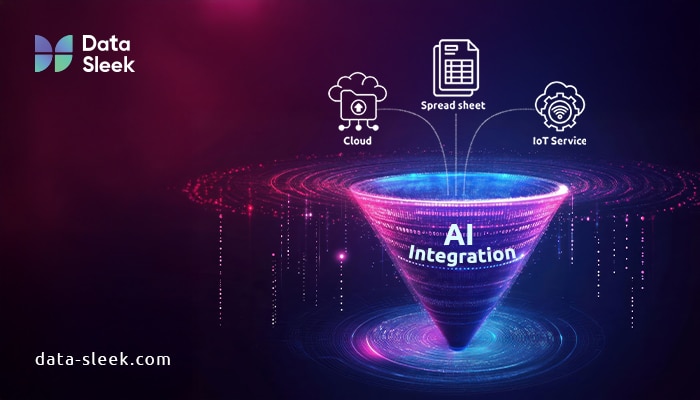
We’ll also see increased convergence between data warehousing, BI, and AI platforms, enabling unified analytics environments where models are trained, deployed, and refined within the warehouse ecosystem itself.
Self-Optimizing and Autonomous Warehouses
Looking further ahead, the next evolution will be self-optimizing data warehouses that use AI to continuously adjust their own storage, compute allocation, and performance settings. These systems will intelligently balance cost, speed, and accuracy without human intervention.
Long-term trends will also include AI-driven security and compliance engines. These detect potential breaches in real time, interpret regulatory changes, and automatically enforce policy updates, closing the loop between data governance and infrastructure.
Conclusion
AI is no longer a theoretical advantage in data warehousing; it’s a strategic imperative. As businesses strive to make faster, smarter decisions in real time, AI is transforming the data warehouse from a passive repository into an intelligent engine for growth.
But unlocking its full value requires more than deploying new tools. Organizations must modernize infrastructure, close skills gaps, and align people, processes, and platforms to support intelligent data operations. The path forward isn’t just technical, it’s organizational.
At Data-Sleek, we partner with companies to modernize their data infrastructure and implement practical, business-aligned AI solutions. Whether you’re exploring AI for the first time or scaling an existing data platform, our team works with you to design and deliver strategies tailored to your goals, tools, and stage of growth. Now is the time to act and book a free consultation.


